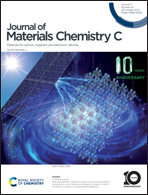Activating the (101) facets of Cu2WS4 in the CdS/Cu2WS4 S-scheme heterojunction to enhance the photocatalytic hydrogen evolution activity
Abstract
Exploring effective strategies to develop new and efficient photocatalysts for photocatalytic hydrogen evolution is of great significance for the development of hydrogen conversion technology. In this work, CdS particles were grown on Cu2WS4 by an in situ growth method, and a CdS/Cu2WS4 S-scheme heterojunction with strong redox ability was synthesized. It fully utilizes the large area (101) surface exposed by Cu2WS4 for catalytic reactions. CdS is dispersed on the surface of Cu2WS4, activating its (101) facet to consume photo-generated holes, thereby promoting charge carrier transfer. In addition, the introduction of Cu2WS4 not only provides a platform for CdS growth, but also constructs S-scheme heterojunctions between the contact interfaces, which is instrumental in the separation and migration of electron–hole pairs. Due to the synergistic effect of (101) facet activation and the S-scheme heterojunction, the CdS/Cu2WS4 heterojunction exhibits surprisingly high hydrogen evolution activity, which is 21.3 and 33.4 times higher than that of CdS and Cu2WS4, respectively. In addition, according to the basic experimental characterization and density functional theory calculations, the formation of the CdS/Cu2WS4 heterojunction effectively improves the separation efficiency of photogenerated electron–hole pairs, and thus enhances the photocatalytic redox performance. This work provides a strategy for designing and developing high-performance photocatalysts.



 Please wait while we load your content...
Please wait while we load your content...